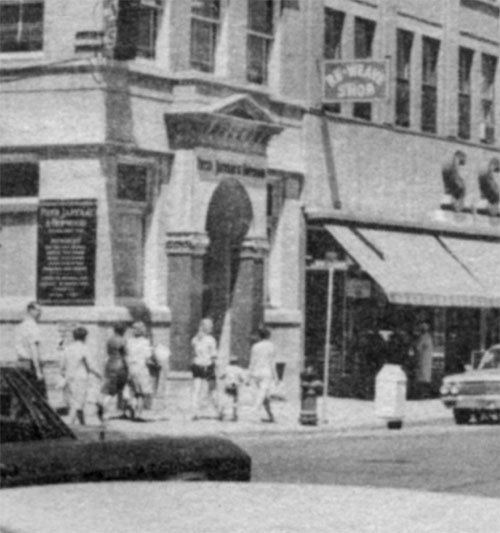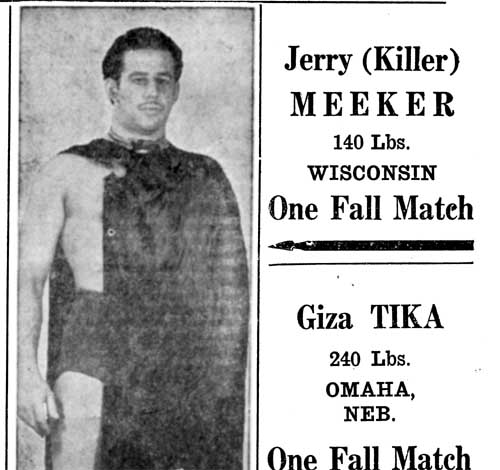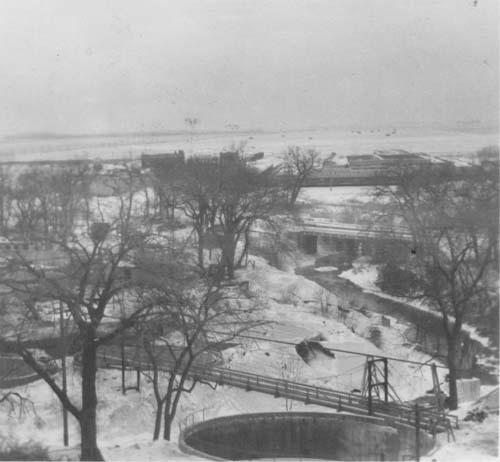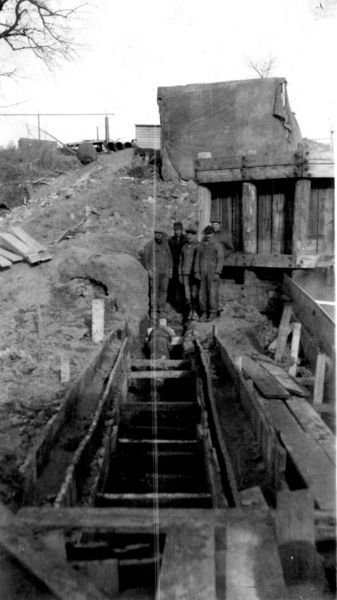 |

| |
|
|  |
Red River Flood, 1952.
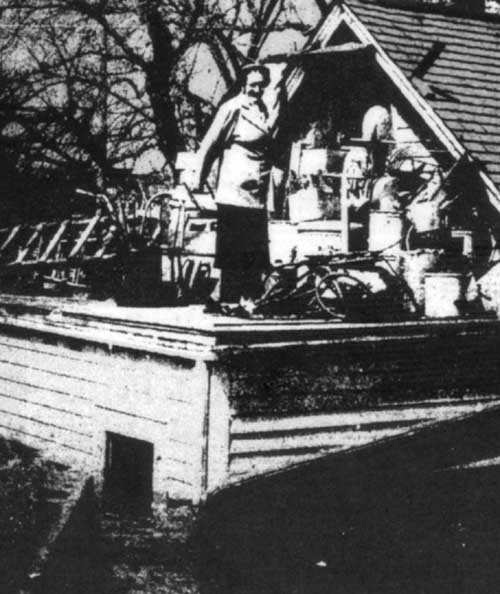
Click for full imageMrs. Colin Campbell would not be ousted from her home: she is standing on the roof of her back porch, after climbing out a second story window. The water is about 4 feet away from covering her feet, but she was non-plussed; in the accompanying article, she defied police attempts to evacuate her, declaring it was a good time to catch up on her embroidery. On April 16, 1952, the Red River crested at around 35 feet; a USGS paper declared it the highest crest since 1897. Her address, 106 1st Avenue South, no longer exists; Urban Renewal wisely razed the neighborhood south of Main and east of 4th street, which was regularly subject to inundation even in light flood years. Labels: 1950s, 1952, fargo, fargophilia, flood, red river
Red River Flood, 1897.
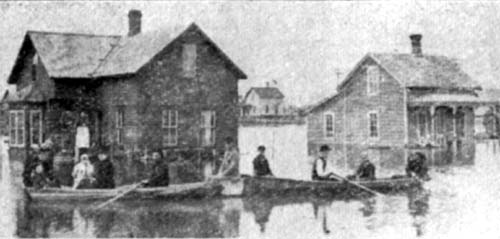
Click for full imageToday, Fargo-Moorhead is readying itself for an unbelievable 40ft+ crest of the Red River on Friday, and are preparing, around the clock, by filling sandbags and building dikes. Twelve years ago we had another huge flood which filled some neighborhoods with water, a hundred year flood so to speak. In fact, a hundred years before that hundred-year flood was the 1897 flood, seen above: floods of this type weren't completely unusual — urban renewal cleared out the most flood-prone neighborhoods during the 1970s on both sides of the river, which had been routinely inundated whenever the river got high. The area of Moorhead in the photo above, however, is still on high ground and is residential: the building on the left seems to still exist, while the one on the right does not. The USGS believes the 1897 flood hit the 40-foot mark as well. Labels: 1890s, 1897, fargophilia, flood, red river
Jerry "Killer" Meeker, 1945.
Scenic North Dakota Winter, 1930s.
NDSU's Downtown Expansion
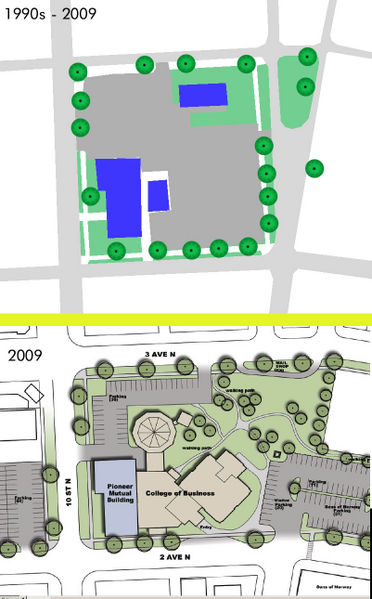 I hadn't realized this when I was going over NDSU's PML Building expansion: the Y-shaped section of 9th St North directly behind the building will be adsorbed into the NDSU Downtown campus. The wedge of green houses six mailboxes (due to one-ways it allows drivers to drop their mail off out the car window), several trees and a flower garden, and the Statue of Rollo. It appears that Rollo will stay on the grounds, and an accommodation for the mail drop will exist on 3rd Avenue (a one-way going East). I'm pleased with two things: an increase in downtown green area, and a reduction in downtown parking lots. Even when the PML building was completely occupied, the lot was rarely full - remember, the lot across the street to the west also belongs to the PML building as well. If there's one thing I hate about downtown Fargo, it's too many parking lots, not enough buildings. I don't like the loss of a downtown street, though; several other north-south streets have been closed off in the past few years due to building expansion and train safety. Labels: fargophilia, ndsu downtown, pioneer mutual building
Cinerama-70 in Fargo
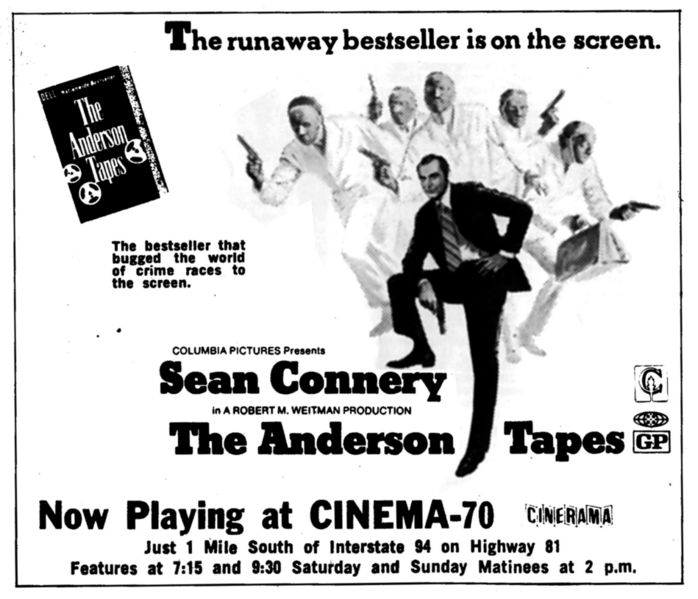 I don't remember the Cinema-70, but by the time I was old enough to become a moviegoer it had changed to a 3-screen, 35mm multiplex like all the rest in town, where I had to sit on my mom's lap for Return of the Jedi because it was so full. The theatre closed shortly after, and sat vacant for a decade, until it was torn down and turned into a parking lot for the gym next door. In 1971, however, it was a single-screen "Cinerama 70" theatre. In the 1960s, whoever built the theatre banked on the belief that Cinerama, the wide-aspect-ratio film style popularized in the late 50s and early 60s, would be there to stay. By the 1970s Cinerama was rarely used, few studios even had equipment to film in it, and it had been bastardized from the original 3-camera setup to an anamorphic widescreen format. The Anderson Tapes was filmed on standard 35mm film with a normal aspect ratio, which left over half of a Cinerama screen unused. It's no wonder the theatre broke up their one-room schoolhouse into a three-screen theatre. On the right-hand side of the ad, it looks like a typo, but not really: 1971 was in some of the early years of the MPAA's voluntary film rating system. "GP" was the replacement for the "M" rating, when people found the "M" and "R" ratings too hard to tell apart. "GP" meant, essentially, what "PG" means today, but too many people thought it meant "general public", thus confusing it with the "G" rating. There was just a narrow 2-year window when "GP" was used. Labels: 1970s, 1971, cinerama, fargophilia, movie theatre
The Red River Mall
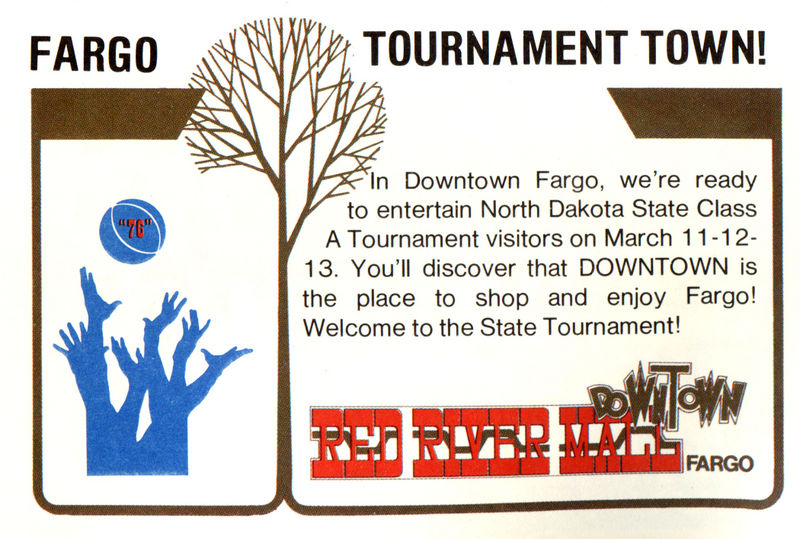 I remember the "mall" from my youth, but it barely registers that it ever actually had a name. The Red River Mall was a misguided attempt to revitalize Fargo's downtown, which (whether directly or indirectly) led to downtown Fargo's near-collapse in the late 80s and early 90s, and forcing the renewal plans that threaten to cause another Red River Mall-like slump. In the 1960s and early 1970s, the nationwide Urban Renewal movement hit Fargo and Moorhead: Moorhead got an actual indoor mall to replace the dozens of retail stores and apartments downtown. Fargo got tall buildings, open spaces, and the Red River Mall. The Mall wasn't a direct knee-jerk reaction to the creation of the West Acres Mall, but it was hoped to counter the movement of stores away from the downtown area. Fargo's retail center stretched from around 8th Avenue north to 5th Avenue South, and extended east to around 2nd Street and west to 10th Street. Modern Fargoans may be wrinkling their brows at this range, wondering how downtown Fargo was ever that big: today, Downtown starts at 6th Avenue and stops at Main, and barely extends a block off Broadway. The rest of those buildings? They were replaced by modern office buildings, they burned and were paved over instead of rebuilding, they were sacrificed in favor of flood protection, they were demolished to create parking lots, and they got absorbed by their neighbors. So, by the early 1970s, Downtown Fargo was in a poor position: it had a number of department stores, but its retail influence was shrinking. Small malls were popping up at the edges of town where new houses were being built. And then, West Acres gave the department stores the final boost to move out. That left large, empty buildings, struggling locally-owned stores, and a loss of shoppers. The city, in its infinite wisdom, saw the possibility of turning Downtown Fargo into something akin to Nicollet Mall in Minneapolis. Here's how the plan went: Broadway, formerly two lanes with parking along all sides, would be turned into a winding, parking-less, snake-like street emulating the curvy nature of the Red River. Keeping to the curvy road, large cement pylons would mark the borders. To appeal to pedestrians, at their appropriate places along the "river", marble place-markers represented the border cities. To keep rain and snow off pedestrians, overhanging roofs would line the street close to the buildings. Trees remained, or were planted for aesthetic reasons, with nice sitting places scattered throughout. As you might guess, with the loss of large stores shoppers weren't going downtown much, and now that Broadway was difficult to navigate they were less likely to do so. Sidewalk ceilings helped some, but weren't enough encouragement. The Red River Mall eliminated a lot of downtown parking, which caused more buildings to disappear from along the streets, further reducing retail spaces in exchange for mostly-empty parking lots. In 1976, optimism was still high: the Red River Mall was still an attraction. It was only a year or two after West Acres' debut, so there was less evidence of replacement, as opposed to an expansion of retail opportunities. Downtown stores hoped that regional events like the basketball tournament would draw shoppers to our repackaged 'shopping mall' and stop by. Eventually, it became clear that the Red River Mall was nothing more than shiny wrapping paper on an unwanted, regifted chotchke: even its name slowly dropped out of popular use, and Broadway's retail influence all but stopped. Labels: 1980s, 1982, broadway, fargophilia, red river mall
Ever-Expanding Fargo
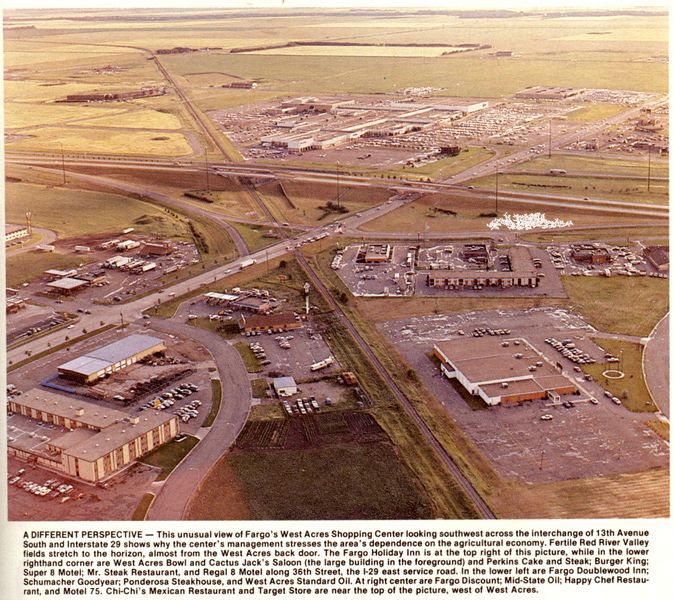 If you had no idea that Fargo has grown in leaps and bounds, let's look back 25 years. In 1982, this photo was taken for the Binford Guide to commemorate the 10th anniversary of West Acres Mall. The mall is seen in the upper-center area of the photo -- and beyond that are miles and miles of farmland. 45th Street, barely visible at the top edge (it was a dirt road then) is about a mile from I-29: today ( see a Google Map), the green, lush farmland you see is almost entirely paved and filled with a zoo, the YMCA, the largest Scheels store in the world, a 6-story office building (in which the Infomercantile webserver lives), and numerous other offices, strip malls, big-box retailers, and apartment buildings. The growth of the Fargo area is dumbfounding sometimes; when they talk about rural areas shrinking in population, it's because they're coming to the bigger cities. One thing I find most interesting, from both the photo and the aerial map, is the identification of what's new versus what's old based on the railroad line that used to run through this part of town. Buildings built on the diagonal were there before the tracks were removed; buildings on the north-south lines are new. Labels: 1980s, 1982, fargophilia, west acres mall
Inside Black's Store Without A Name
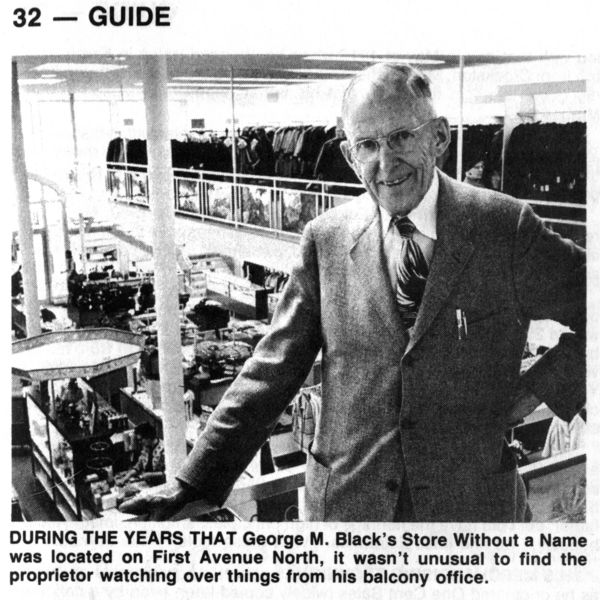 Meet George M Black. The big building on Broadway, the one sprouting up from Elm Street Square today, bear this gentleman's name. In 1912, Black opened up his own department store -- Black's -- on that spot and began buying up the surrounding property. Black sold his store to Sears and used the money to build the Black Building -- but he wasn't out of the department store racket yet. The photo above, scanned from a Binford Guide article about the sale of the Black Building in '86, is of Black overlooking his post-1929 department store. Black had sold his previous store to Sears lock, stock, barrel, and name, resulting in a guy with retail smarts but no catchy name anymore. His solution: call his new shop The Store Without A Name. The marketing was witty -- he held a contest to pick a new name, but to everyone's surprise the majority of the votes went to keep the department store nameless. One bright suggestion was to abbreviate it to the 'Swan', but that didn't have the sticking power of the unnammed shop. The Store Without A Name is now the parking lot next to the Avalon; the Black Building ceased being a department store when Sears moved out to the mall in '76. Labels: black building fargo, fargophilia, sears
The Last Binford Guide
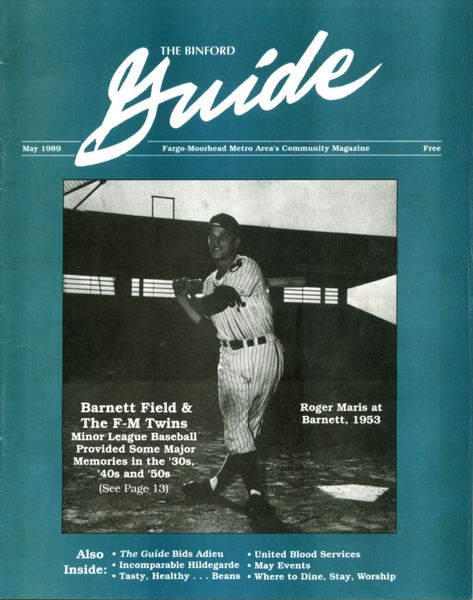 Howard Binford Howard Binford was a journalism icon in the Fargo-Moorhead area during the 60s and 70s, training the media personalities of the future and publishing his own magazine. Late in life, Binford starting publishing his Howard Binford's Guide in 1968, interviewing a series of locals who were quite obviously Binford's friends, church acquaintances, advertisers, and co-chairs on local boards. Still, he was a bright and entertaining editorialist, and the magazine was actually useful to non-locals on holiday and residents alike. Looking forward, Binford began to pass control to his assistants in 1984, sold the magazine to a local publisher in 1986, but his health got the better of him at the end of 1988 and he passed away. Without Binford, the Guide ended publication with the May 1989 issue. The Guide was clearly valuable to the community: most of the magazines I've collected were aquired in large lots -- people saved years and years of the guide in their basement. I've got almost the entire 1980s uploaded, a good part of the 70s, but those 1/8th-size pre-1975 Guides are tough to find. Labels: 1980s, 1989, fargophilia, howard binford's guide
Buckskin Harry, Fargo TV Cowboy
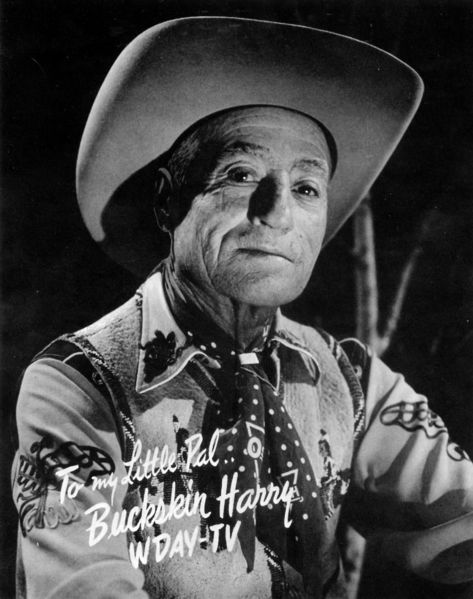 Buckskin Harry Buckskin Harry, as far as I can tell at this time, was a local television personality here in Fargo. Back in the day, local television stations did a lot more local programming than just the news; a lot of the national kids' shows like Bozo the Clown had its roots in local TV stations. Even into the 1980s local stations had thematic characters do intros and commercial bumpers for horror movies. We found this photo in a 1950s magazine, so it gave us a pretty good idea of about when 'ol Buckskin graced the boob-tube. Our first resource was my grandparents -- Grandpa Vernon remembered Harry on TV in the 1950s, but Grandpa was nurturing a new family around that time and wasn't watching mid-afternoon kids' programming. Going through a 1955 Fargo Forum, I found some more specific information: Buckskin was on at 4 in the afternoon, an excellent timeslot lead into by Pinky Lee and Howdy Doody -- and Buckskin's show ran for an hour and fifteen minutes. I'm still doing my digging (my research method consists of doing very little, randomly encountering information...it works pretty well, actually), but if anybody out there remembers Buckskin, I'd appreciate any info. Labels: 1950s, 1955, Buckskin Harry, fargophilia, WDAY
When Flair Was King
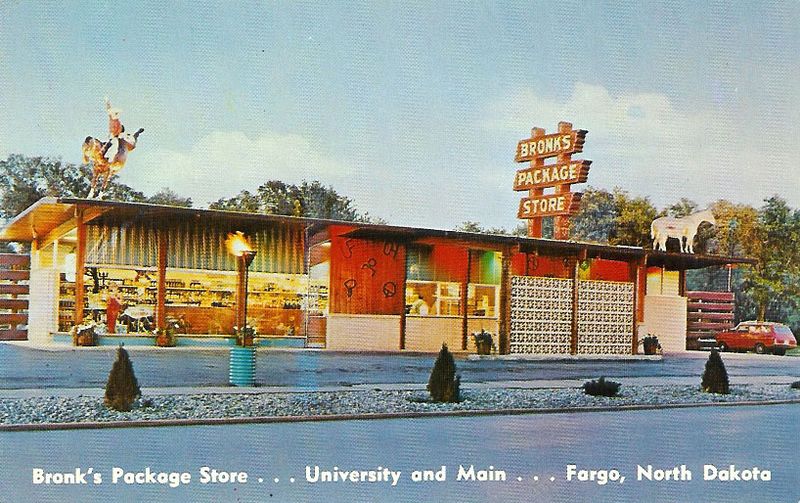 About a month ago, I drove past that ugly modern office building on the corner of Main and University, and struggled to remember what was there before. Then, I found this postcard, and memories rushed back in. No, I don't think I was ever in Bronk's (we were a Polar Package Place family; it was closer to our home), but its central location in Fargo and garish exterior would make it hard to forget. I'm going to look through my archives and see if I can dig up any more on Bronk's, but I don't remember seeing anything about it recently. Today, garish exteriors are reserved for children's restaurants and theme buffets -- the interior of a liquor store isn't inherently anything, let alone to be 'themed' to attract customers. Modern stores aim for neutral efficiency, and 'vice' stores want to project professionalism lest they be called uncouth...but back in the day, when someone said to stop at the liquor store with the cowboy on top, you darn well knew where to go. Bronk's disappeared in the late 80s by my recollection, and was replaced by a law office building. No cowboys on the top of the law offices, sadly. Labels: 1970s, bronk's, fargo, fargophilia, liquor store
Rusk Auto-House Found
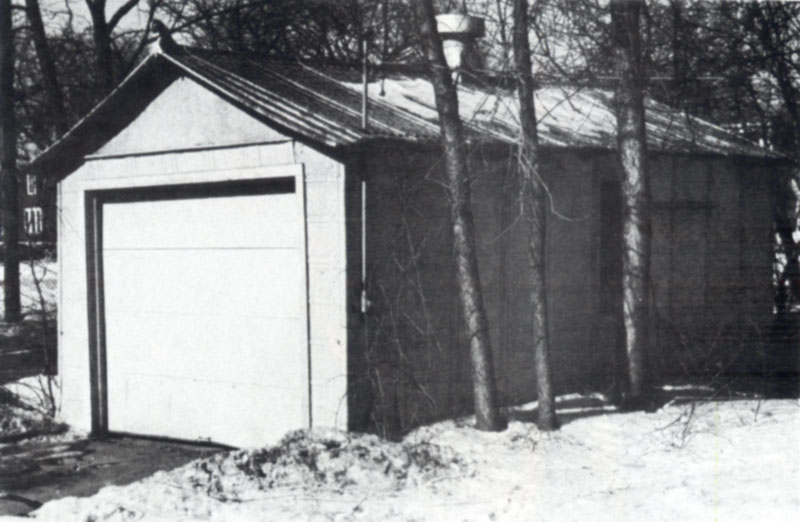 When I first learned about the Rusk Auto-House, I discovered that one was placed on the National Register of Historic Places, Building #87002634 -- but the address didn't make sense. I walked around that block, and found nothing but parking lot. I assumed it was torn down quite some time ago, but in going through my Binford Guide archive I found a photo of that very Rusk. Located on a house's driveway exiting on to 7th avenue, a half block west of Broadway and facing St. Mary's Cathedral, sat this pressed-steel garage. That was in 1988; the garage must have disappeared not long after, as I don't ever remember anything on that corner except parking lot. Labels: 1980s, 1988, fargophilia, national register of historic places, rusk auto-house
Howard Binford's Guide
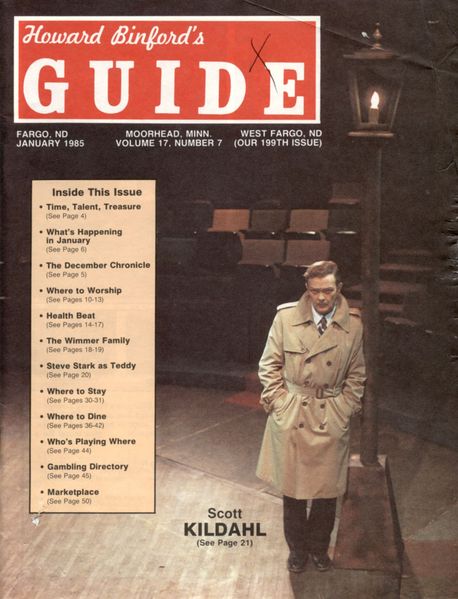 Howard Binford was a journalism instructor at Moorhead State University when he started his magazine: Howard Binford's Guide, a free publication for tourists or other non-locals providing handy lists of places to eat and sleep, who's performing in town, and other things of interest in the Fargo-Moorhead area. The magazine ran from 1968 until Binford died in 1989, with some changes throughout (as you'd expect in over 20 years of publishing), but the magazine kept its content and tone through the years. The magazine was sold to Kaye's printing in 1986, and after Binford's passing Kaye's continued publishing as "Fargo-Moorhead Magazine" -- after which they, themselves, were bought by the Fargo Forum. The magazine started in '68 by a teacher continues today through the largest regional publisher in the Red River Valley. Each Guide had a profile or interview with some local dignitary; hardly a whos-who of international fame, Binford wrote about an interesting group of local religious leaders, businessmen, regional government, and amateur performers. Labels: downtown fargo, fargophilia, howard binford's guide, magazine
|  |
|
|













